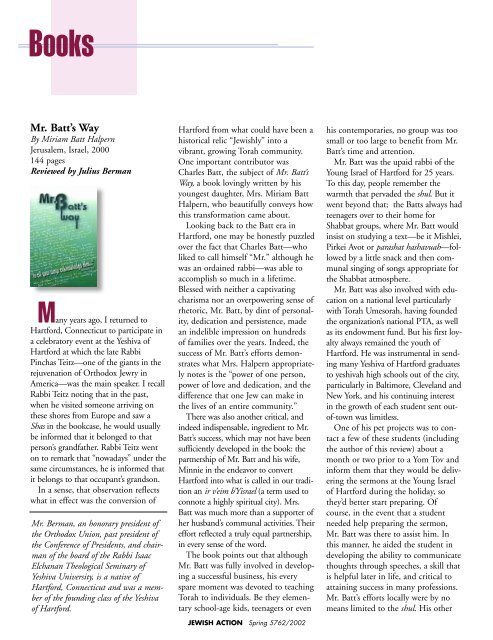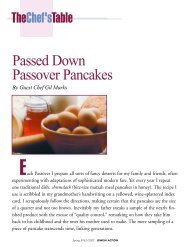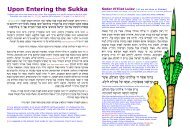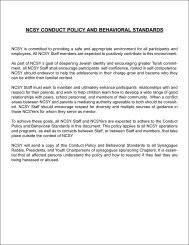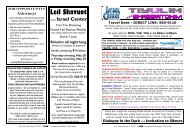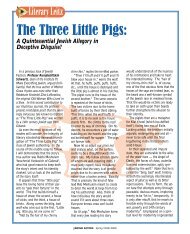Create successful ePaper yourself
Turn your PDF publications into a flip-book with our unique Google optimized e-Paper software.
Books<br />
<strong>Mr</strong>. Batt’s <strong>Way</strong><br />
By Miriam Batt Halpern<br />
Jerusalem, Israel, 2000<br />
144 pages<br />
Reviewed by Julius Berman<br />
Many years ago, I returned to<br />
Hartford, Connecticut to participate in<br />
a celebratory event at the Yeshiva of<br />
Hartford at which the late Rabbi<br />
Pinchas Teitz—one of the giants in the<br />
rejuvenation of <strong>Orthodox</strong> Jewry in<br />
America—was the main speaker. I recall<br />
Rabbi Teitz noting that in the past,<br />
when he visited someone arriving on<br />
these shores from Europe and saw a<br />
Shas in the bookcase, he would usually<br />
be informed that it belonged to that<br />
person’s grandfather. Rabbi Teitz went<br />
on to remark that “nowadays” under the<br />
same circumstances, he is informed that<br />
it belongs to that occupant’s grandson.<br />
In a sense, that observation reflects<br />
what in effect was the conversion of<br />
<strong>Mr</strong>. Berman, an honorary president of<br />
the <strong>Orthodox</strong> <strong>Union</strong>, past president of<br />
the Conference of Presidents, and chairman<br />
of the board of the Rabbi Isaac<br />
Elchanan Theological Seminary of<br />
Yeshiva University, is a native of<br />
Hartford, Connecticut and was a member<br />
of the founding class of the Yeshiva<br />
of Hartford.<br />
Hartford from what could have been a<br />
historical relic “Jewishly” into a<br />
vibrant, growing Torah community.<br />
One important contributor was<br />
Charles Batt, the subject of <strong>Mr</strong>. Batt’s<br />
<strong>Way</strong>, a book lovingly written by his<br />
youngest daughter, <strong>Mr</strong>s. Miriam Batt<br />
Halpern, who beautifully conveys how<br />
this transformation came about.<br />
Looking back to the Batt era in<br />
Hartford, one may be honestly puzzled<br />
over the fact that Charles Batt—who<br />
liked to call himself “<strong>Mr</strong>.” although he<br />
was an ordained rabbi—was able to<br />
accomplish so much in a lifetime.<br />
Blessed with neither a captivating<br />
charisma nor an overpowering sense of<br />
rhetoric, <strong>Mr</strong>. Batt, by dint of personality,<br />
dedication and persistence, made<br />
an indelible impression on hundreds<br />
of families over the years. Indeed, the<br />
success of <strong>Mr</strong>. Batt’s efforts demonstrates<br />
what <strong>Mr</strong>s. Halpern appropriately<br />
notes is the “power of one person,<br />
power of love and dedication, and the<br />
difference that one Jew can make in<br />
the lives of an entire community.”<br />
There was also another critical, and<br />
indeed indispensable, ingredient to <strong>Mr</strong>.<br />
Batt’s success, which may not have been<br />
sufficiently developed in the book: the<br />
partnership of <strong>Mr</strong>. Batt and his wife,<br />
Minnie in the endeavor to convert<br />
Hartford into what is called in our tradition<br />
an ir v’eim b’Yisrael (a term used to<br />
connote a highly spiritual city). <strong>Mr</strong>s.<br />
Batt was much more than a supporter of<br />
her husband’s communal activities. Their<br />
effort reflected a truly equal partnership,<br />
in every sense of the word.<br />
The book points out that although<br />
<strong>Mr</strong>. Batt was fully involved in developing<br />
a successful business, his every<br />
spare moment was devoted to teaching<br />
Torah to individuals. Be they elementary<br />
school-age kids, teenagers or even<br />
JEWISH ACTION Spring 5762/2002<br />
his contemporaries, no group was too<br />
small or too large to benefit from <strong>Mr</strong>.<br />
Batt’s time and attention.<br />
<strong>Mr</strong>. Batt was the upaid rabbi of the<br />
Young Israel of Hartford for 25 years.<br />
To this day, people remember the<br />
warmth that pervaded the shul. But it<br />
went beyond that; the Batts always had<br />
teenagers over to their home for<br />
Shabbat groups, where <strong>Mr</strong>. Batt would<br />
insist on studying a text—be it Mishlei,<br />
Pirkei Avot or parashat hashavuah—followed<br />
by a little snack and then communal<br />
singing of songs appropriate for<br />
the Shabbat atmosphere.<br />
<strong>Mr</strong>. Batt was also involved with education<br />
on a national level particularly<br />
with Torah Umesorah, having founded<br />
the organization’s national PTA, as well<br />
as its endowment fund. But his first loyalty<br />
always remained the youth of<br />
Hartford. He was instrumental in sending<br />
many Yeshiva of Hartford graduates<br />
to yeshivah high schools out of the city,<br />
particularly in Baltimore, Cleveland and<br />
New York, and his continuing interest<br />
in the growth of each student sent outof-town<br />
was limitless.<br />
One of his pet projects was to contact<br />
a few of these students (including<br />
the author of this review) about a<br />
month or two prior to a Yom Tov and<br />
inform them that they would be delivering<br />
the sermons at the Young Israel<br />
of Hartford during the holiday, so<br />
they’d better start preparing. Of<br />
course, in the event that a student<br />
needed help preparing the sermon,<br />
<strong>Mr</strong>. Batt was there to assist him. In<br />
this manner, he aided the student in<br />
developing the ability to communicate<br />
thoughts through speeches, a skill that<br />
is helpful later in life, and critical to<br />
attaining success in many professions.<br />
<strong>Mr</strong>. Batt’s efforts locally were by no<br />
means limited to the shul. His other
primary area of devotion was the<br />
Yeshiva of Hartford, where he was<br />
president for 18 years and heavily<br />
involved with for many more.<br />
<strong>Mr</strong>s. Halpern also notes that the<br />
“familial” aspect of the yeshivah was<br />
unique, with no clear lines of division<br />
between teachers, supporters and administrators.<br />
All became part of the extended<br />
yeshivah family, and shared one common<br />
goal: to participate in developing<br />
young boys and girls into mature adults<br />
who would make their academic and<br />
professional mark in the world while<br />
remaining true to their religious roots.<br />
Even the <strong>Orthodox</strong> <strong>Union</strong> was a<br />
beneficiary of <strong>Mr</strong>. Batt’s efforts. I recall<br />
that shortly after being elected president<br />
of the OU in 1978, I received a<br />
call from him in which he said that if<br />
the organization considered itself a<br />
Torah institution, it should open its<br />
meetings with a dvar Torah. That<br />
innovation has lasted to this very day.<br />
He called me subsequently to urge<br />
another project upon the <strong>Union</strong>: our<br />
participation in the Mishnah Yomit<br />
concept, noting that being a union of<br />
synagogues, the OU was in a unique<br />
position to do this effectively. Again,<br />
we successfully adopted a Batt proposal,<br />
developing it into our monthly<br />
publication, Luach & Limud, which<br />
continues to provide a daily dose of<br />
Torah learning to subscribers throughout<br />
the world.<br />
<strong>Mr</strong>s. Halpern sums up her father<br />
best when she writes the following:<br />
Charles Batt changed the lives of<br />
many. Having come in contact with him<br />
changed even people who met him casually.<br />
He affected others in a positive way<br />
just by being himself: a sincere, honest<br />
Jew who accepted life and tried each day<br />
to be the best he could be, a man who<br />
loved Judaism and wanted everyone to<br />
partake in a taste of its splendor.<br />
<strong>Mr</strong>. Batt’s <strong>Way</strong> is a relatively small<br />
book that does not pretend to be a<br />
full-blown biography. However, while<br />
conveying the highlights of Charles<br />
Batt’s life, it certainly demonstrates the<br />
power that a dedicated couple can<br />
have in molding the religious character<br />
of an entire community. JA<br />
The Man Who Stopped The<br />
Trains To Auschwitz<br />
George Mantello, El Salvador, and<br />
Switzerland’s Finest Hour<br />
By David Kranzler, with a Foreword by<br />
Senator Joseph I. Lieberman<br />
Syracuse University Press<br />
Syracuse, NY, 2000<br />
341 pages<br />
Reviewed by Shlomo Slonim<br />
This volume recounts the extraordinary<br />
deeds of an extraordinary man<br />
during the darkest hours of Jewish history,<br />
when satanic figures sought to<br />
totally destroy every Jewish community<br />
in fulfillment of the Final Solution.<br />
It reveals how one person, George<br />
Mantello, managed, in the most<br />
remarkable circumstances, to save<br />
from certain death the remnants of an<br />
entire community, that of Budapest,<br />
with its surviving 140,000 Jews. By<br />
mid-1944, half of the Jewish population<br />
had already been transported to<br />
Auschwitz and massacred, and<br />
Eichmann and his Gestapo henchmen<br />
were fiendishly intent on completing<br />
the destruction of the last major<br />
Jewish community in occupied<br />
Europe. Their resolve weakened not a<br />
whit even as the Nazi regime, facing<br />
imminent defeat by the concerted<br />
Allied onslaught from east and west,<br />
was in its last gasps.<br />
The case related in this volume is<br />
unique because of its scope and,<br />
beyond that, because it demonstrates<br />
what might have been done much earlier,<br />
on a more massive scale, to rescue<br />
European Jewry had the leaders of the<br />
Allied powers and Jews in positions of<br />
JEWISH ACTION Spring 5762/2002<br />
responsibility acted with comparable<br />
commitment, devotion and determination.<br />
In particular, as the author points<br />
out, Mantello’s achievements put the<br />
lie to the thesis enunciated by William<br />
D. Rubinstein in his book, The Myth<br />
of Rescue: Why the Democracies Could<br />
Not Have Saved More Jews from<br />
the Nazis (New York: Routledge,1997).<br />
Britain, of course, compounded<br />
matters by slamming shut the doors of<br />
Eretz Yisrael at the moment of greatest<br />
need, when multitudes of Jews might<br />
yet have been saved had they been able<br />
to reach that safe haven. In this manner,<br />
Britain was almost as complicit in<br />
Hitler’s destruction of European Jewry<br />
as were the Arabs at whose instigation<br />
the infamous “White Paper” was<br />
issued. Just how callous the British<br />
attitude could be in the face of the<br />
most horrid act of butchery that the<br />
world has ever seen is perhaps best<br />
revealed by the remark of British<br />
Deputy Prime Minister Clement<br />
Atlee, in 1942. Privy as he was to all<br />
the intelligence coming out of Eastern<br />
Europe, he could still declare, “The<br />
Jews are always desirous of putting<br />
themselves at the head of the queue of<br />
the suffering”!<br />
In 1943 and 1944, when the<br />
machinery for destroying humans en<br />
masse was operating at full blast,<br />
Allied leaders, fully informed of the<br />
facts, could not even spare a few<br />
bombs to destroy the gas chambers<br />
and the railroads that were being used<br />
to transport tens of thousands daily<br />
into Auschwitz. This failure to act was<br />
itself a crime against humanity. It represented<br />
a deliberate decision to desist<br />
from interfering with, and frustrating,<br />
further implementation of the Nazis’<br />
systematic program of genocide.<br />
Winning the war, quite clearly, did not<br />
encompass saving Jewish lives en<br />
masse. Regrettably, public opinion in<br />
the Allied countries was never sufficiently<br />
informed or powerful to compel<br />
their governments to act to<br />
interdict the transports into<br />
Auschwitz.<br />
What happened in Switzerland in<br />
1944, as described by Kranzler, pres-
ents a stark contrast to this dismal picture.<br />
Mass popular protests were<br />
staged, objecting strenuously to the<br />
continued deportation of the Jews to<br />
Auschwitz and condemning the<br />
Hungarian government for its role.<br />
These protests were led by church and<br />
communal leaders who, in turn, had<br />
been energized by Mantello (not, be it<br />
noted, by the Swiss government).<br />
Grassroots Swiss pressure led the<br />
Hungarian government to suspend<br />
further deportations, despite the<br />
…in what was<br />
perhaps the greatest<br />
single act of rescue,<br />
the last remnants<br />
of Budapest Jewry<br />
were spared the fate<br />
of their brethren,<br />
thanks in no small<br />
measure to the<br />
dramatic<br />
intervention of one<br />
determined individual.<br />
threats and blandishments of<br />
Eichmann and his cohorts. Thus, in<br />
what was perhaps the greatest single<br />
act of rescue, the last remnants of<br />
Budapest Jewry were spared the fate of<br />
their brethren, thanks in no small<br />
measure to the dramatic intervention<br />
of one determined individual.<br />
Mantello’s career up to the war hardly<br />
presaged the talents, vision and<br />
tenacity which he would summon to<br />
fulfill a central role in the mass rescue<br />
of Jews. Born in 1901 in Transylvania<br />
to a well-to-do Jewish family, George<br />
Mandl (he subsequently changed his<br />
name to Mantello) received a basic<br />
Jewish education in the town of<br />
Klausenberg, attended a commercial<br />
high school for three years and studied<br />
at a military college during World War<br />
I. At the end of that conflict he<br />
engaged in business, primarily in the<br />
field of banking and finance. As a<br />
member of a Revisionist youth group,<br />
he visited Eretz Yisrael in the 1920s<br />
and even hiked with the group from<br />
Haifa to Jerusalem. Upon his return to<br />
Europe, he settled in Romania and<br />
became the manager of a bank. His<br />
connections with non-Jews in the<br />
business world subsequently facilitated<br />
his escape from the clutches of the<br />
Germans and his efforts to rescue<br />
other Jews. In 1942 he moved from<br />
Romania to Switzerland and, as a<br />
result of his friendship with the El<br />
Salvadoran ambassador in that country,<br />
was appointed first secretary (honorary)<br />
at the El Salvadoran embassy.<br />
This conferred on him diplomatic status<br />
with the right to travel anywhere<br />
and enjoy diplomatic immunity. From<br />
being a shrewd and successful businessman,<br />
Mantello now became a oneman<br />
dynamo working tirelessly to<br />
bring Jews to safety. He performed<br />
numerous miracles of rescue, but his<br />
greatest achievement was his intervention<br />
on behalf of Budapest’s remaining<br />
Jews in 1944, which, as the title of this<br />
book denotes, “stopped the trains to<br />
Auschwitz.”<br />
The author, Professor David<br />
Kranzler, is to be commended for<br />
bringing to light, in absorbing detail,<br />
an exalted chapter in human resolve<br />
and courage. The book, whose importance<br />
is justly highlighted by Senator<br />
Joseph Lieberman in his foreword, is<br />
indeed “powerful and moving.” Few<br />
would have heard of Mantello before<br />
the publication of this book; none<br />
who read the account will ever forget<br />
the deeds of a single dedicated hero in<br />
the most harrowing period in human<br />
history. JA<br />
JEWISH ACTION Spring 5762/2002


